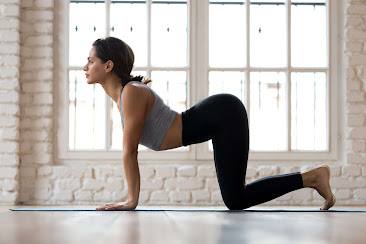Body Posture Is Maintained By
Body posture is maintained by cerebellum which is a part of hindbrain. The cerebellum plays a crucial role in maintaining body posture and balance. It receives sensory input from various sources, including the inner ear (vestibular system), visual system, and proprioceptive system (sensors in muscles, joints, and tendons). It then processes this information and sends signals to different parts of the body to adjust and maintain posture.
Read this blog in hindiSimplified Explanation Of How the Cerebellum Helps Maintain Body Posture:
1. Sensory Input:
The cerebellum receives continuous sensory input from the vestibular system, which provides information about the position and movement of the head, as well as the visual and proprioceptive systems.
2. Integration:
The cerebellum integrates the incoming sensory information and compares it with previously stored information about the body's position and movements.
3. Error Detection:
The cerebellum compares the actual body position and movement with the desired or intended position and movement. It detects any errors or discrepancies between the two.
4. Motor Output:
If an error is detected, the cerebellum sends signals to various parts of the body, including the muscles, to make the necessary adjustments. These signals help in coordinating and refining muscle activity to maintain or restore proper body posture.
5. Fine-Tuning:
The cerebellum continuously fine-tunes the motor commands based on ongoing sensory input and feedback. It adjusts the timing, force, and coordination of muscle contractions to maintain balance and stability.
The cerebellum also communicates with other areas of the brain involved in posture control, such as the brainstem and the motor cortex, to coordinate posture-related movements.
It's important to note that this is a simplified explanation, and the actual processes involved in maintaining body posture are more complex and involve multiple brain regions. The cerebellum's precise functioning in posture maintenance is an active area of research in neuroscience. So we can say that body posture is maintain by cerebellum.
Body Posture Maintain By Help Of Yoga
Yoga is an excellent practice for maintaining and improving body posture. Here are a few yoga poses that can help enhance posture:
1. Mountain Pose (Tadasana):
Stand tall with your feet together or hip-width apart. Lengthen your spine, engage your core muscles,
and roll your shoulders back and down. This pose helps to align the body and improve overall posture.
2. Downward Facing Dog (Adho Mukha Svanasana):
You may also like:The New Normal In Our Life:Adaption tips and stratigies
Start on your hands and knees, then lift your hips up and back, forming an inverted V-shape with your body. Press your palms into the mat, lengthen your spine, and engage your abdominal muscles. Downward Dog stretches and strengthens the entire body, including the back, shoulders, and hamstrings.
3. Cat-Cow Pose (Marjaryasana-Bitilasana):
Begin on your hands and knees in a tabletop position. As you inhale, lift your tailbone and head while allowing your belly to sink towards the mat (Cow Pose). As you exhale, round your spine and tuck your chin towards your chest (Cat Pose). This pose helps to mobilize and align the spine.
4. Cobra Pose (Bhujangasana):
Lie on your belly, place your hands under your shoulders, and press the tops of your feet into the mat. Inhale as you lift your chest off the ground, keeping your shoulders down and away from your ears. Cobra Pose strengthens the back muscles and helps counteract slouching.
5. Warrior II (Virabhadrasana II):
You may also like:Characteristic Of Being Introvert ,How to overcome it
Stand with your feet wide apart, turn your right foot out, and extend your arms parallel to the floor. Bend your right knee, aligning it over your ankle, and gaze over your right fingertips. Warrior II helps strengthen the legs, open the chest, and improve overall posture.
6. Bridge Pose (Setu Bandhasana):
Lie on your back with your knees bent and feet flat on the mat. Press your feet into the ground as you lift your hips, creating a bridge shape with your body. Keep your shoulders relaxed and engage your glutes. Bridge Pose strengthens the back muscles and opens the chest.
Remember, consistency is key when practicing yoga to improve posture. Regularly incorporating these poses into your routine, along with a focus on alignment and body awareness, can gradually improve your posture over time. It's always a good idea to consult with a qualified yoga instructor to ensure you are practicing the poses correctly and safely.









0 टिप्पणियाँ
Hey guys, if you liked the blog or have suggestions for us please comment it down. It will help us to improve😊